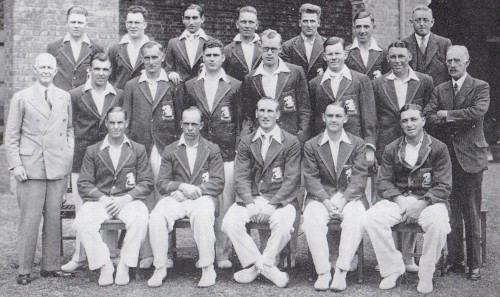
In his 21st over yesterday, Stuart Broad induced Steve Smith into a false shot, the ball looped from the bat’s leading edge over the gully area and landed safely on the lush turf at Old Trafford.
As a young man, Third Man was lucky to meet and spend a lot of time with Eddie Cooper, Worcester’s opening batsman either side of the Second World War. In the Sixties he was recognised as the best coach in England – a regular at cricketing brains trusts at Lilleshaw.
Eddie’s favourite story was of batting against the ’48 Invincibles in the opening tour match, captured by Pathe News (45 seconds in). Eddie liked the cut. Not many could cut Lindwall. Eddie could. The first cut shot crossed the turf and slammed into the fence. Bradman at mid-off sidled over to Lindwall for a chat. Eddie was surprised to find another shortish ball coming down at him outside off. He climbed into without a second thought, cutting the ball back to the fence from where it has just been retrieved.
Again and again in his innings he cut the Australian attack. Finally, in the seventies, he cut another delivery into the hands of backward cover. As he passed Bradman on the way back to the Pavilion, the great Australian smiled at him and said, “Cheap at the price son.”
What price would England pay to have Smith leaving the field, bat under his arm? 50 … 60 … 70 runs?
Coincidentally, Smith probably has a similar back-lift to Bradman. Out it starts towards gully before coming around and down in a glorious uninterrupted flow, not dissimilar to a Federa forehand. But critically not straight down. The direction it falls is slightly across the line of the ball. His wonderful eye and superb timing means that he misses very few even with this weakness – for it is a weakness.
England tried to exploit this weakness yesterday bowling a fifth stump line. But on the fifth stump line Smith plays for the straight delivery. If the ball cuts away from him he misses it as a dozen balls were yesterday. If it jags back, the impact with his pads is outside the line of the off stump. Cute? Invincible?
Bradman would know how to get him out.
England have to speculate to accumulate. They have to bowl straighter. Not wider. Smith relishes the ball bowled at his pads, not playing around that pad as most do, but with the front foot hardly moved forward so that line of the bat looping round and down from square shoulders and hips is free to strike the ball in a wide arc of possible directions to leg. (That’s how Eddie a student of Bradman coached the shot too.)
If the ball is straight, the impact is secure and it’s one or four depending on the positioning of the leg side field. If it jags in there is a small danger of an edge towards a leg slip but as likely or not it’s a leg bye or a simple miss. But if it nips back from a leg-side angled seam like the ball Broad bowled in his 21st over yesterday, it strikes the leading edge and pops up somewhere between gully and short extra cover.
Anderson can bowl that delivery at will; Broad too and Archer.
It needs a precise field; plenty of cover on the leg side, catchers in slips and gully, and a man in short on the off side for the leading edge which loops in front of rather than behind square. It needs a willingness to ‘leak’ runs to one of the batsman’s favourite shots. Finally it needs to appeal to the batsman’s ego; to know the risk, and to accept the risk.
How fitting that a man who summons the very image of Bradman the batsman could be dismissed by a ruse worthy of Bradman the captain.
* Photograph Worcestershire 1946 with Eddie Cooper centre of back row with cravat













